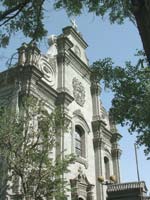|
Churches for Christmas
By Ed Lanfranco (Beijing Weekend)
Updated: 2004-01-14 13:28
With Christmas coming soon, Around Town offers a brief look at two of Beijing's houses of worship.
Church at the crossroads
 Zhushikou Protestant Church celebrates its centenary. It is located at the busy intersection of Zhushikou Xidajie and Qianmen Dajie. Last-minute Christmas shoppers might want to take note of the cool pair of Peking Opera supply shops across the street. Zhushikou Protestant Church celebrates its centenary. It is located at the busy intersection of Zhushikou Xidajie and Qianmen Dajie. Last-minute Christmas shoppers might want to take note of the cool pair of Peking Opera supply shops across the street.
The Qianmen road was the path taken by emperors on their way from the Forbidden City to the Temple of Heaven for imperial sacrifices at the Winter Solstice. Zhushikou, meaning Pearl Market entrance, dates from the Ming dynasty (1368-1644) when it was known as Pig Market. When the market closed in the Qing period (1644-1911) the name changed, but the pronunciation didn't. Pigs and pearls are homonyms; the written characters differentiate them.
Until this year city planners had been debating whether or not to raze the church, a structure right next to the new boulevard informally called liang guang. This is the multi-lane Guang'an-Guangqu Boulevard cutting a wide swathe of modern transportation through Beijing's south central Xuanwu and Chongwen districts.
Construction and expansion of the three-storey Methodist denomination edifice took place several times over a 17-year-period between 1904 and 1921. It was one of the first multiple storey buildings in south Beijing.
One of the unique features of the small church is that during religious services the congregation worships on three different floors simultaneously, linked together by an in-house video system. If you speak Chinese, call 6301-6678 for service times.
Nantang
 Catholics and Chinese history aficionados might want to consider going to Beijing's Nantang, or South Church, for Christmas Mass. The Church of St. Mary, as it is also known, was first erected here in 1650. Catholics and Chinese history aficionados might want to consider going to Beijing's Nantang, or South Church, for Christmas Mass. The Church of St. Mary, as it is also known, was first erected here in 1650.
Located at 141 Qianmenxi Dajie, it is the site of the first permanent Jesuit mission in Beijing dating back to 1605 when the greatest of the Jesuits, Matteo Ricci (1552-1610), was able to purchase land after living in Beijing for four years.
A product of the European Renaissance who dedicated himself the Catholic cause in China, Ricci was renowned for his scientific knowledge and amazing memory skills. Few realize his intellectual acumen included real estate.
Back when the capital was still a Ming fortress walled city, Xuanwumen, the Gate of Proclaimed Military Strength, was considered to be unlucky because it was the portal used when the condemned were taken to the execution ground. Ricci bought the property cheaply and it is still used by adherents of his faith nearly four hundred years later.
Call 6607-6538 for information in Chinese and limited English regarding Christmas and other service times.
|
